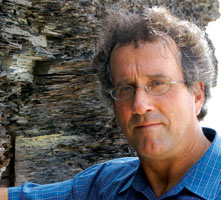 Dr. Gary Lash of the Geosciences Department |
Pioneering research by Dr. Gary Lash into the sedimentary rock formation known as Marcellus black shale, which is believed to contain vast reserves of natural gas and oil, has placed the longtime SUNY Fredonia geosciences professor into an ultra-selective fraternity that spans the globe.
Dr. Lash has been named by Foreign Policy magazine to its “Top 100 Global Thinkers” list for 2011.
How prestigious is this list? Included in the top 20 among the 2011 roster are such names as President Barack Obama, Federal Reserve Chairman Ben Bernanke, Facebook Founder Mark Zuckerberg and Microsoft Founder Bill Gates and his wife, Melinda.
Lash, together with Penn State colleague Dr. Terry Engelder and Texas oilman George P. Mitchell, can be found at number 36.
Published by the Slate Group, a division of the Washington Post Company, Foreign Policy is a global publication devoted to economics, politics and ideas.
Lash and his co-honorees were designated top global thinkers for “upending the geopolitics of energy.” According to the publication, their ground-breaking research and the subsequent attention they attracted to the tremendous reserves of tightly packed natural gas and oil within the Appalachian basin (which stretches from southwestern New York through much of Pennsylvania and into West Virginia, Maryland and Ohio) has the potential to fundamentally reorder “the global balance of energy and the political power that comes with it.” Their big number – 1,400 trillion cubic feet – brought the matter to a wide audience, transforming shale gas into a global issue in the development of greener energy.
“That’s what started it,” Lash said of the volume that could equate to perhaps 70 years’ worth of cleaner burning hydrocarbon. Gas shale deposits are now gaining attention globally. New deposits are under examination in more than 35 nations, including Israel, Poland, Ireland, Argentina, Canada, Australia and Mexico. “I suspect that this may be the principal reason for our recognition,” Lash said. “We advanced the discussion regarding the abundance of gas held by these deposits.”
Lash, a structural geologist and stratigrapher/sedimentologist with a doctoral degree in geology from Lehigh University, began investigating exposed shale formations along the Lake Erie shoreline some 15 years ago. He helped to establish the SUNY Fredonia Shale Research Institute as a means of coordinating industry interest in organic-rich shale with academic research efforts.
Lash has been interviewed by CNN Money and was a keynote scientist on “Crude,” a documentary presented on the History Channel.
Marcellus gas deposits have become accessible through the application of new drilling techniques and hydraulic fracturing – commonly referred to as “fracking” – which involves the use of water and small amounts of chemicals pumped into wells at high pressure to release gas and oil deposits.
Now in his 31st year at SUNY Fredonia, Lash received a more than $130,000 grant from the New York State Energy Research and Development Authority in 2007 to fund research to facilitate oil and gas exploration by improving analytical techniques that assess rock formations. More recently, his research has been supported by Chesapeake Energy, EQT, Shell, Seneca Resources, Chief Oil and Gas, and Thermo Fisher Scientific.
Lash’s current research focuses on the inorganic geochemistry of the Marcellus and other shales using highly sophisticated equipment that analyzes shale formations for trace elements and metals. Resulting data can be used to deduce the chemical conditions under which the shale accumulated, assess the potential that a rock will respond favorably to fracking, and even gain insight regarding the Earth’s climate at the time the shale was deposited.
Despite a relatively low price for natural gas, drilling is booming in Pennsylvania, Lash reported, and New York could become active in select areas in 2012 upon lifting of a drilling moratorium. A major issue that must be resolved, he explained, is the proper disposal of water produced during drilling operations, which includes water used in fracking as well as the highly saline water naturally held in the rock.
It seems appropriate that SUNY Fredonia figures prominently in natural gas exploration in the 21st century. The first commercial well in Devonian black shale was drilled in downtown Fredonia in 1825, and the first natural gas company in the U.S. was incorporated here as well. Indeed, the first fracked well was completed in Fredonia in 1858 by Preston Barmore, a graduate of the Fredonia Academy, a forerunner of SUNY Fredonia. Today, Chautauqua County is the most heavily drilled county in the state.
Lash attended a Dec. 1 reception that recognized the new crop of “Global Thinkers” at the Meridian International Center in Washington, D.C.



